Center of Gravity: What We Can Learn From Spanish Television’s Casa de Papel
Eric Collin
The Holy Grail
Like the mystery of the pyramids or the recent findings in Holy Scripture, the Center of Gravity concept has all the ingredients to generate passionate debates. The 19th century master of military theory, Carl von Clausewitz, first introduced the concept in his unfinished manuscript published after his death[1]. It remained largely unknown, like old papyrus, until it was poorly translated to English[2] and resurrected in Western military theory in the 1980’s as THE key for victory! Since then it has taken on the status of military theory’s ‘Holy Grail’ and fueled countless quests for truth and understanding[3] [4].
In the Dutch and Belgian Advanced Staff Course students discover that the Centre of Gravity (CoG) concept is one of the most important tools of NATO’s operations planning process[5]. Everything they have heard and read about CoG reinforces its Holy Grail or silver bullet status that is the key to solving problems. However, like the myth surrounding the Holy Grail, a shroud obscures understanding of the CoG concept. This article discusses an approach used in the Belgian and Dutch Defense Colleges that cuts through the shroud making the concept understandable, unequivocal and fruitful for our students. The cutting blade is a CoG identification methodology combined with a novel case study, the Spanish crime drama, Casa de papel. (In the U.S. it is NETFLIX’s The Heist)
The Problem
The challenge military planners face is finding the most efficient way to reach an end state or objective imposed by higher authorities while facing competitors trying to reach another end state. Centuries of military planning and NATO doctrine provide ways to solve that problem which encompasses different cognitive tools, among them the CoG concept[6]. The CoG concept suggests a path to finding the ‘efficient way.’ Unfortunately, year after year the CoG concept generates more circular discussions, confusing papers and pointless debates. Eventually frustration and disgust set in. Students ask: “How can something so important to planning not have a clear definition and a practical method to identify it?” The answer is rather surprising, yet simple. Despite the CoG’s lofty status in military theory, NATO, nor any NATO country, has adopted a crystal clear and official methodology to support the CoG quest.
Because Clausewitz did not provide a CoG identification methodology, NATO included Dr Joe Strange’s 1996 interpretation of the CoG[7] in its operations planning process (OPP) toolbox. Unfortunately, Dr. Strange only introduced a CoG analysis model, not a COG identification methodology. His model assumes a correct identification, but provides no method to identify it. To make matters worse the CoG’s doctrinal definitions continuously changed and lacked uniformity. This is like saying “the CoG is important, but we don’t really know what it is.” Therefore, Allied Joint Publication 5 and the NATO School’s operations planning course, lacked a clear simple methodology to identify the CoG. Consequently, NATO nations and headquarters struggled in its application leading to endless back and forth discussions between Joint Operations Planning Group (JOPG) members.
The Breakthrough
The CoG concept and its analysis aim at increasing our understanding of the actors in an environment. The key problem of the CoG is that there is no commonly accepted definition and hence no methodology to find it which only undermined the concept’s validity. After many years of practice and research, the Belgian Defence College opted for the definition first proposed by Professor Dale Eikmeier, Associate Professor at the Department of Joint, Interagency, and Multinational Operations of the U.S. Army Command and General Staff College and adopted by the Australian Defense Forces: “The CoG is the primary entity that possesses the inherent capability to achieve an objective or the desired end state.”[8] The advantages of this definition, clarity, logic, precision and testability, have been explained by Professor Eikmeier in numerous papers. Settling on a definition was the first step. The second was finding a useful identification method.
Based on that definition, I suggested to my colleagues within Department Joint Operations to use a slightly modified Strange-Eikmeier method to teach the CoG. While the method was a significant step forward, the CoG concept still didn’t come alive in the student’s minds. A third step was required so I designed explanatory example or case study to bring the concept to life.
Casa de Papel
Confronted with the difficulty of explaining a rather abstract concept teachers usually try to use case studies to illustrate its applicability. However, our historical military case studies required huge amounts of reading that overwhelmed the sensibility of our students. Additionally historical military case studies often proved a distraction from the CoG’s concepts by seducing students in ‘red herring’ discussions of historical accuracies or tactics and technology. Hence the idea of using a non-military, non-historical confrontation scenario which is quickly understood by everyone.
Spanish Television’s crime drama Casa de Papel (US NETFLIX’s The Heist) proved to be the perfect case study. Imagine you want to get a minimum 1 billion euro in a limited time – the end state. The selected option or way, directed by higher, is to rob a bank. Let’s thus imagine that you and your “friends” will oppose the security personnel of the bank and the police who want to reach exactly the opposite end state – money safe and secure. As Clausewitz (and now NATO doctrine) stated: if you want to succeed, you need to protect and enable your CoG. The question is: what is it?
Papel proved to be the perfect case study. It was simple, easily understood, yet outside of the students’ experience. In Papel students still have to wrestle with ends (objectives/outcomes), ways (courses of action/ capabilities) and means (resources/requirements). Most importantly, it allowed student to apply the 7 steps methodology discussed below in a scenario free from military or historical distractions.
NATO doctrine is quite clear, finding a center of gravity requires an understanding of the adversary including how he operates (his potential Courses of Action) and the environment[9]. After several iterations the approach developed at the Belgian Defence College meets NATO’s intent. This approach to CoG identification and analysis includes 7 steps.
The first step is to define the operational objective. In Casa case study we want a huge amount of money without earning it, by robbing a bank.
The second step is to list the candidate critical capabilities (CC) that will achieve the objective (see figures below). In order to avoid long discussions on which capability is related to the primary ability to reach the objective we ask the students to list all capabilities essential to reach the objective -the next steps will logically lead to the correct conclusion about the criticality of the capabilities. This is the first benefit of the exercise: put on paper the main abilities (linked to potential Courses of Actions). This forces the students to imagine how the actions will unfold.
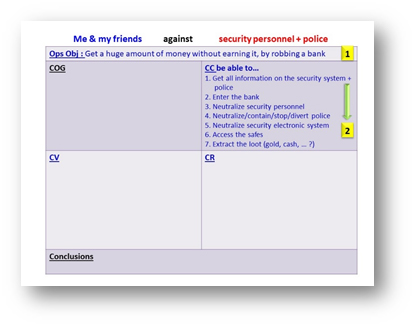
The third step is listing of all critical requirements (CR) needed to enable the critical capabilities listed on step 2.
The fourth step is the application of the Eikmeier ‘does’ & ‘uses’ tests to find the CoG[10]. A CoG is a doer and uses requirements. So all CRs that are not ‘doers’ are set aside. Those remaining are candidates for the ‘uses/used’ test: if a CR uses one or more other CRs, then it is a CoG candidate. In this case we start with the C² (structure) that is used by all other CRs (you need a C² to plan and coordinate all actions) and thus it is rejected as possible CoG, because it is ‘used’. The further application of the test leads us to select the extraction team as the CoG, the people who will be in charge of extracting the loot from the bank, which is the primary critical capability that achieves the objective. They are the doers that actually rob the bank.
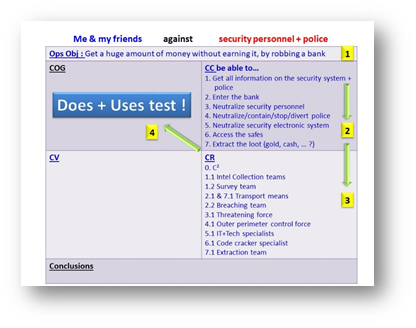
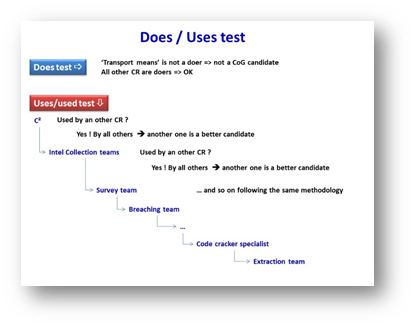
Step 5 is a goes back to the CC list. We identify ‘subordinate CCs from the list that the CoG does not perform (that we later will move them to the CR list – see paragraphs below). In this case almost all CCs except the last one: extract the loot. As predicted on step 2, the ‘uses’ test, delivered the primary capability, the one that leads directly to the final objective; get the money by robbing the bank.
NATO AJP-5 says: “If it is an important or even essential entity, but not the primary entity used by the actor to achieve its objectives, then it is a critical requirement for the real CoG”[11]. Therefore we ask the students to verify that all subordinate CCs were well “translated” into CRs during step 3.
Step 6 and 7 are the classical but essential ones – according to doctrine - of finding the critical vulnerabilities (CV) of all remaining CRs and derive what we have to do with them, in this case, protecting our own CoG, being the extraction team. For the security service of the bank and the police, it will be exactly the opposite: they will try at all costs to exploit our vulnerabilities in order to neutralize the critical requirements and hence make the CoG irrelevant.
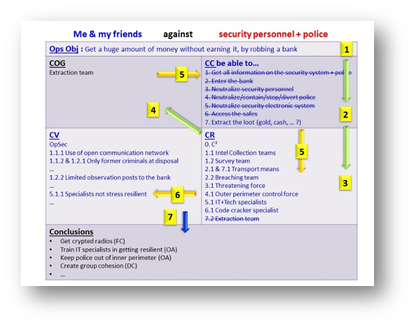
This methodology offers the possibility to highlight the main take-aways of a CoG analysis being:
- The ability to identify which requirements must be protected at all costs /targeted on both sides (red/blue and possibly green)
- The ability to identify the CVs that are linked to an indirect approach to protect/neutralize the CoG and, possibly, the CVs for a direct approach (not part of the NATO doctrine and not illustrated in the methodology above but by a similar study of the CVs directly linked to the CoG)
- Last but not least the fact that this tool forces the staff to first formalize an idea of the different steps of the operations framework and visualize how activities relate to one another within the operation.
It is also important to note that this example allows the freedom to choose different CoAs to meet the objective.
Decisive Action
To clarify, Professor Eikmeier simply restated a very essential element of Clausewitz’s thoughts in On War, “The heaviest blow is that struck by the center of gravity.” [12] The CoG is what will perform the decisive action being the primary entity to achieve the objectives[13]. Once translated in a process plate the does/uses test appears clearer: CRs are those requirements necessary to shape the environment and to empower the CoG so that it can perform the decisive action(s).
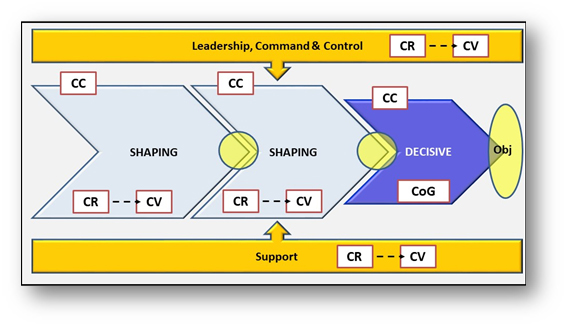
On the Right Path
According to my experience the traditional mistake planners make is to think that the CoG is the most critical of the critical requirements. This is not the case! I have had hours of discussion with tens of officers ranking from captain to lieutenant-general about this misconception and especially during one of the last NATO major exercise with planners arguing that the air force was the CoG because without the air force it was simply impossible to win. They were right: without the air force it was impossible to win and therefore it is a critical requirement, but not the CoG, because reconquering and defending a country – which was the final objective of that exercise –cannot being done by air force alone. The land response force was the doer, the CoG, because it alone could reconquer and defend a country. The air force was a critical requirement - used by the CoG - and therefore its critical vulnerabilities had to be protected!
The Belgian Defence College shared its methodology with Professor Eikmeier and he provided some positive comments. He found that the Casa scenario was a, “good example of an asymmetric environment. The robbers’ method to rob the bank is only limited by their imagination and access to resources or talent”. The asymmetry forces the students to look at the scenario with a broader perspective and avoid formulaic solutions. He also stated that “you do something very interesting, and something I had not thought about. You go from CCs to CRs which creates a list of means/resources available or needed. I go from CCs to the COG (derived from a separate list of means) then CRs that the COG requires. You then use the Does/Uses test to screen the CR’s to determine the COG. Both work and will arrive at the same destination.” [14]
The very essence of this process is that it is a more objective and logical process to identify the CoG and avoids time wasting subjective and unfruitful discussions. Additionally it keeps the Planning Group focused on the essence of planning without losing half of the group because of frustration. The College has already tested this method with positive results with students attending the Candidate Senior Officers Course and the Advanced Staff Course. When compared with previous methodologies, the students gained a better understanding of the situation, had better insights on their campaign plan and were less frustrated at the end of the day!
Moreover encouraging signs are coming from NATO: the new AJP-5 has already integrated many elements of this approach in its annex B[15] - but it has still no convincing methodology - and SHAPE recently changed its view and now starts the analysis with capabilities derived from the desired outcome[16]. NATO school in Oberammergau, Germany, invited recently Professor Eikmeier for a lecture and used his ideas and methodologies. Let’s hope they will integrate his methodology into their courses.
This methodology combined with an imaginative case study may contribute to the CoG identification and analysis, losing its Holy Grail status, but at least planners will have regained the use of a powerful tool. I just hope not to disappear mysteriously in the next months, which would suggest that the CoG concept is struggling to remain unreachable.
End Notes
[1] Carl von Clausewitz, Hinterlassene Werke des Generals Carl von Clausewitz über Krieg und Kriegführung Theil 1-2-3, Berlin, Germany: Ferdinand Dümmler, 1832-1834. The concept of center of gravity is part of the second and third volumes of “Vom Kriege” respectively book 6 chapter 27 and book 8 chapter 4.
[2] Antulio J. Echevarria II, Clausewitz’s center of gravity: changing our warfighting doctrine- again!, Carlisle Barracks, PA, USA: Strategic Studies Institute, US Army War College, September 2002, pp. 9-10
[3] Alexandris Konstantinos, Center of gravity : how an old concept is implemented today, Gloucester, United Kingdom: Allied Rapid Reaction Corps (ARRC) journal 2019, pp. 16-27
[4] Ion CHIORCEA, Cristian ABAIANIŢI, Center of gravity – essential element of operational design, Bucharest, Romania: ”Carol I” National Defence university, Proceedings of the 13th international scientific conference, April 2017, pp. 24-38
[5] NATO, Allied Command Operations Comprehensive Operations Planning Directive COPD Interim v2.0, Mons, Belgium: Supreme Headquaters Allied Europe, October 2013, pp. 3-27 & 4-45-4-46
[6] Ibid., chapters 3 & 4
[7] Joe Strange, Centers of Gravity & Critical Vulnerabilities, Quantico, VA, USA: U.S. Marine Corps Association, 1996, pp. 93-96 and Dr. Joe Strange, Colonel Richard Iron, Understanding centers of gravity and critical vulnerabilities – part 2, Washington, DC, USA: Joint Force Quartely, National Defense University, 25 p.
[8] Dale Eikmeier, Modernizing the Center of Gravity Concept- So It Works, part of “Addressing the Fog of COG”, Fort Leavenworth, KA, USA: US Army Combat Arms Center, pp. 133-169
[9] NATO, Allied Joint Doctrine for the planning of operations – AJP-5 Edition A version 2, Brussels, Belgium: NATO Standardization Agency, May 2019, p. B-3
[10] Dale Eikmeier, Center of gravity analysis, Fort Leavenworth, KA, USA: Military Review, July-August 2004, p. 3
[11] NATO AJP-5 (A v2), p. B-3
[12] Carl von Clausewitz, On War, trans. and eds. Michael Howard and Peter Paret, Princeton, NJ, USa: Princeton University Press, 1984, p. 485
[13] NATO AJP-5 (A v2), p. B-2
[14] Dale Eikmeier, e-mail to Eric Collin, Brussels, Belgium, 18 October 2019.
[15] NATO AJP-5 (A v2), pp. B-1 – B-14
[16] SHAPE lecture on NATO Strategic Planning given at Belgian Defence College to Advanced Staff Course, December 02nd 2019
About the Author(s)
Comments
We are committed to…
We are committed to providing our clients with exceptional solutions while offering web design and development services, graphic design services, organic SEO services, social media services, digital marketing services, server management services and Graphic Design Company in USA.
Fabulous blog I found from…
Fabulous blog I found from this website which is on center of gravity. Keep sharing such kind of more blogs.
Regards, Jack. http://www.qualitydissertation.co.uk/assignment-writing-help
Enjoyed the novel approach…
Enjoyed the novel approach to teaching the CoG concept. We all need to explore more non-military case studies that allow students to explore the concept without the distractions of history. One case study I've been using is the fight against yellow fever in the19th and early 20th century.
